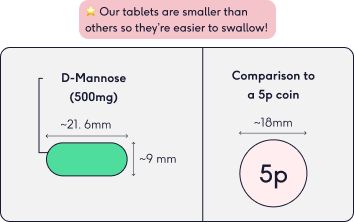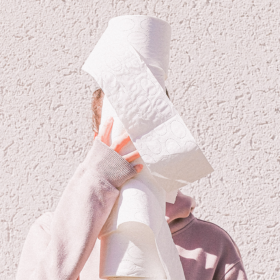
D-Mannose vs Cranberry for UTIs – Which is best?
In this article
What's the lowdown?
Antibiotics are often the go-to for urinary tract infections (UTIs), but there are other treatment options to explore, which could be especially handy for those who experience recurrent UTIs (2 or more infections within a 6 month period)
Cranberries have been said to have a beneficial effect on UTIs for decades, but the research is mixed – they seem to be more of a preventative option than a cure for an active UTI. Buy from Amazon.
Of recent years, D-mannose (taken as a capsule or powder) has received attention as a possible UTI treatment and prevention
Clinical research into D-mannose is looking promising, with results comparable antibiotic treatment
You can buy D-mannose directly from the Lowdown or buy from Amazon here!
This post contains Amazon affiliate links which we earn a small commission from. We only link to products our doctors have reviewed
UTI… the dreaded urinary tract infection. Usually it likes to make its presence known by causing an eye-watering sting while you wee, dull abdominal pain and the constant need to sprint to the loo! It seems unfair that something so common (it’s likely to affect at least ⅓ of all women¹…lucky us) can have such irritating symptoms.
The first port of call for treatment is typically an antibiotic, but factors such as the rise of antibiotic resistance and unpleasant side effects have resulted in increasing interest in other possible treatment options. In this article, we’re going to compare one of the most long-standing home remedies for UTIs, the humble cranberry, with one of the newer kids on the block, D-mannose.
What is a UTI?
A UTI is a collective term to describe an infection which involves the bladder, kidneys, ureter or urethra. Up to 90%of all cases are due to the bacteria Escherichia coli,² which is common in the urinary tract. Many of us experience recurrent UTIs, which is where you experience 2 UTIs in a 6 month period. In fact, studies suggest that there is a 27% chance³ of a second infection within six months after the first.
If you experience UTI symptoms, you may be asked to do a urine test to look for signs of infection. Depending on the result, the advice could be to take a painkiller to manage uncomfortable symptoms and to potentially take a prescribed short course of antibiotics (3 days is usually enough). However, antibiotics are not always needed and symptoms can resolve on their own⁴. Sometimes, the recommendation is to wait 48 hours before taking the antibiotics to see if things improve without them.
It is important to note that if UTI symptoms rapidly worsen, or do not respond to treatments (such as antibiotics), within a couple of days it is important to contact your healthcare team as the infection can spread to the kidney and result in complications. Important signs of worsening infection⁵ include fever, vomiting and pain over the kidney area or loin.
Now, time to take a bit of a diversion into cranberries and D-mannose. Let’s get stuck into how each of them can be beneficial, how they differ and which one might be best for you!
What is D-mannose?
D-mannose is a type of simple sugar called a monosaccharide. This means that it can’t be broken down into any smaller sugar molecules, similar to glucose. D-mannose is commonly found in fruits like apples, oranges….and cranberries!
Is D-mannose the same as cranberry?
D-mannose is found in fruits and vegetables. It also naturally occurs in cranberries. So, if you take cranberry juice or capsules you will also be ingesting some D-mannose.
When you take D-mannose, the body will get rid of it via the kidneys and then the urinary tract. D-mannose attaches to the E.coli bacteria (remember, this is the main culprit for UTIs), which prevents the bacteria from attaching to cells, multiplying and causing the infection.
As cranberry also contains D-mannose, some sources suggest that it treats infection in the same way. However, D-mannose that can be consumed via the diet⁶ is relatively low, so you wouldn’t be able to eat enough cranberries, peaches or even coffee grounds to consume an amount of D-mannose that could have a therapeutic effect!
Differences between D-mannose and cranberry
*If you’re pregnant and experiencing UTI symptoms it is important to speak to a healthcare professional, especially if symptoms worsen or the infection isn’t responding to treatment.

Can cranberry juice or tablets help with UTIs?
Yes, there cranberry juice or tablets can help prevent UTIs. A large Cochrane review (which is the very best type of research, looking at evidence from all the high quailty studies available), found that cranberry juices or tablets can reduce the risk of UTIs in women with recurrent UTIs, children and people who are having treatment for bladder or prostate cancer14.
There is a compound within cranberries, known as proanthocyanidins (PACs), that could be beneficial in treating UTIs. The PACs appear to have a similar effect on E.coli, stopping the bacteria from attaching to the cells within the urinary tract. A 2010 study⁷ concluded that a daily dose of 36 mg of PACs or more had an optimal antibacterial effect in the urine.
So, D-mannose vs cranberry – which is best?
It’s often the way with medical research but caveat number one is that both D-mannose and cranberry treatments for UTIs need further study through well-designed clinical trials in order to make a more conclusive statement.
But, from the studies that are out there, and given the comparisons with antibiotics, there seem to be more significant results when evaluating the effects of D-mannose. Furthermore, while D-mannose seems to both prevent⁸ future infections and reduce⁹ symptoms of an active UTI, cranberries strengths appear to be more on the preventive side¹⁰.
One potential factor which limits the favourable results for cranberry is that there are no standard formulations. The benefits of the PACs have been well documented but because of the widely varying amounts of cranberry given to participants in studies, this may be why the results are mixed.
Can I take cranberry and D-mannose together?
Yes, you certainly can take cranberry and D-mannose at the same time! One 2020 study¹¹ concluded that administering D-mannose with cranberry extract showed ‘an increase in effectiveness when used in combination with empirical treatment for uncomplicated UTIs.’ So, not only is it safe to take both together, but the overall treatment looks to be more effective.

Where can I buy D-mannose?
At the Lowdown we want to make life that bit easier for you, so you can now buy D-mannose capsules directly from on Amazon.
Our medical review process
This article has been medically reviewed for factual and up to date information by a Lowdown doctor.





